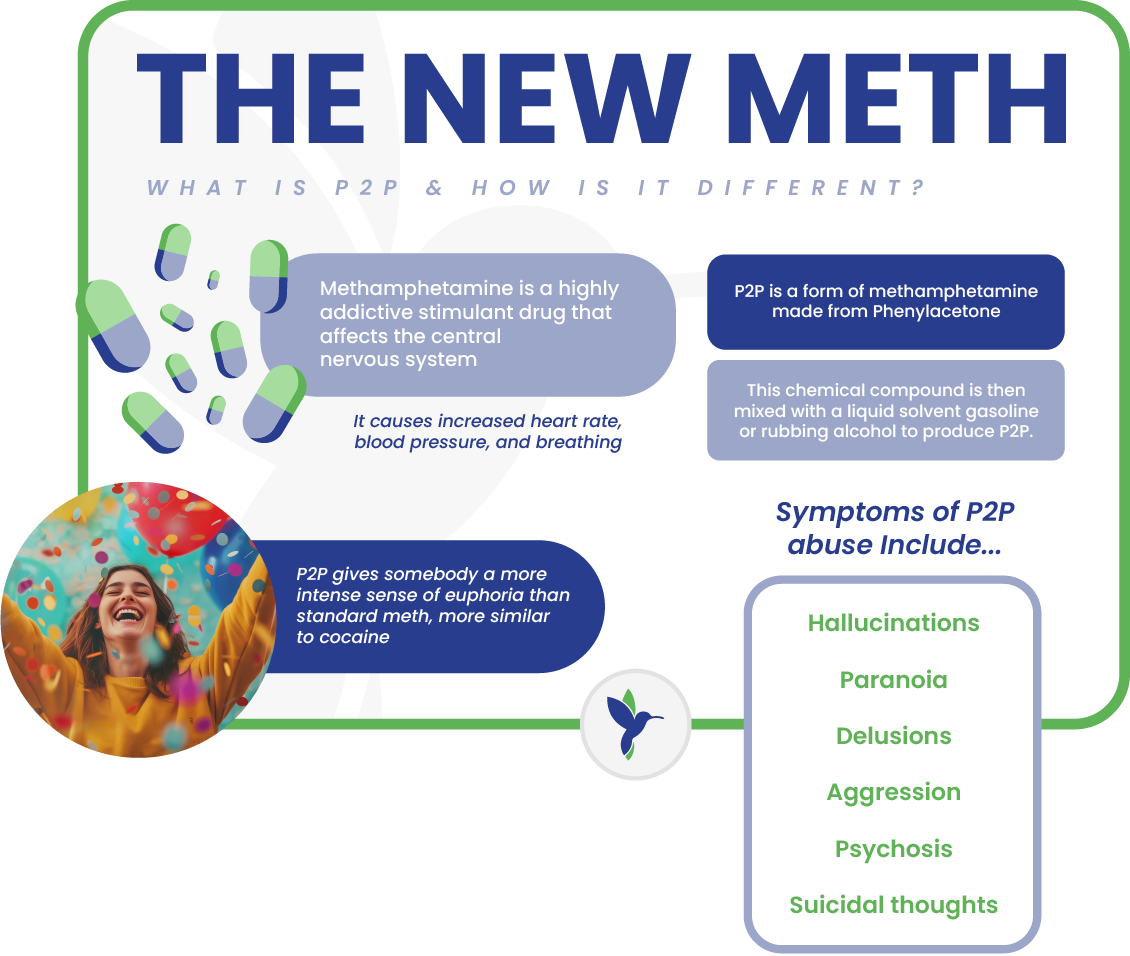The P2P drug is a new form of methamphetamine made by mixing and heating two chemicals together. This process creates a chemical called phenyl-2-propenal, which is similar to amphetamine. Phenyl-2-propenal (P2P) is not regulated like other types of methamphetamine. Once people start using this addictive drug, they may want more and more of it.
What Exactly is Meth?
Methamphetamine is a highly addictive stimulant drug that affects the central nervous system. It causes increased heart rate, blood pressure, and breathing, which may lead to fainting, chest pain, irregular heartbeat, and stroke. Methamphetamine abuse can result in psychosis, hallucinations, paranoia, and suicidal thoughts.
People who take methamphetamine often report feeling “high” or “wired.” They may experience feelings of euphoria, anxiety, depression, irritability, aggression, insomnia, hyperactivity, and sexual arousal. However, these symptoms tend to be short-lived, and users will usually have a “crash” about an hour or two later.

How Does Meth Work?
Methamphetamine works by increasing levels of dopamine — a neurotransmitter found in the brain — in areas of the brain associated with pleasure, motivation, and reward. Dopamine increases energy and alertness while decreasing appetite and sleepiness.
Users typically begin taking methamphetamine for fun and excitement. But over time, they may develop a strong desire to continue using the drug. Some users even need to increase their dose to achieve the same high, as they develop a high tolerance for meth.
Methamphetamine also affects serotonin, another neurotransmitter that plays a role in mood regulation and behavior control. Serotonin decreases when someone takes methamphetamine, causing some users to feel anxious, depressed, and paranoid.
How Do People Get High on Meth?
There are several ways to get high on methamphetamine, including snorting, smoking, injecting, and swallowing. Snorting or smoking methamphetamine produces a faster high than injection or oral ingestion. Injecting methamphetamine into a vein allows the user to build a tolerance to the drug quickly.
Swallowing methamphetamine is the most dangerous way to consume the drug. Users swallow methamphetamine tablets or powder mixed with water. When ingested, the drug enters the bloodstream through the stomach lining.
Swallowing methamphetamine can cause severe damage to the esophagus and digestive tract.
What is the P2P Drug?
The P2P drug is a synthetic drug first made illegal in the United States in the 1980s. It’s similar to crystal meth, which is why many people think they’re the same thing. But P2P meth is a form of methamphetamine made from Phenylacetone, a soluble oil found in organic compounds. This chemical compound is then mixed with a liquid solvent like ether, gasoline, paint thinner, acetone, nail polish remover, or rubbing alcohol to produce P2P.
This P2P drug (“new meth”) is being illegally manufactured in great abundance. This rate of manufacturing the P2P drug is causing steep inclines in usage, causing more people to seek detox and rehabilitation treatment.
What Makes P2P Different From Meth as We Know It?
There are some differences between P2P meth and regular meth. For one thing, P2P meth is made by combining phenyl-2-propenal (a common chemical found in nail polish remover) with pseudoephedrine, which is a decongestant used to treat colds and allergies. This combination creates a powerful stimulant that produces a euphoric high similar to cocaine. In addition, P2P drug users tend to take higher doses than those who use regular meth.
Symptoms and Side Effects of P2P Drug
P2P meth causes many side effects, such as:
- Hallucinations
- Paranoia
- Delusions
- Aggression
- Psychosis
- Suicidal thoughts
It may cause heart palpitations, chest pain, irregular heartbeat, and tachycardia for some users. Long-term anxiety, depression, insomnia, irritability, and mood swings have also been reported. These symptoms can last for weeks after discontinuing use.
Is P2P Meth Different From Other Forms of Meth?
P2P is an abbreviated name for phenyl-2-propanone methamphetamine produced by combining two chemicals. Mixing these two chemicals creates phenyl-2-propane, which is similar to methamphetamine. Phenyl-2-propane is used to make other drugs, such as cocaine and amphetamine.
P2P is made by mixing the chemical precursor phenyl-2-propyne with ephedrine. Ephedrine is a substance derived from the herb ma huang, which contains the addictive compound epinephrine.
Ephedrine is a common ingredient in many cold medications. For example, Sudafed contains ephedra, an extract containing ephedrine.
Why is the P2P Drug Such a Problem?
In recent years, there have been reports of a rise in P2P use among young adults. This trend appears to be related to the increased availability of the drug.
In 2012, the Drug Enforcement Administration (DEA) issued a warning against selling synthetic cathinones like methylenedioxypyrovalerone (mephedrone). These drugs were being sold online under the brand names “bath salts,” “plant food,” “plant food 2,” and “powdered ecstasy.”
The DEA reported that bath salts were being marketed as legal alternatives to MDMA (“ecstasy”) and marijuana. They said that the products contained ingredients not found in traditional bath salts, such as caffeine and pseudoephedrine.
Meth Addiction Treatment in South Florida
Methamphetamine is a highly addictive substance. The “new meth” in the form of the P2P drug could contribute to an increase in addictions nationwide. Ambrosia Treatment Center in South Florida is here to help you or your loved one overcome meth addiction. Call today or visit our admissions page for more.






